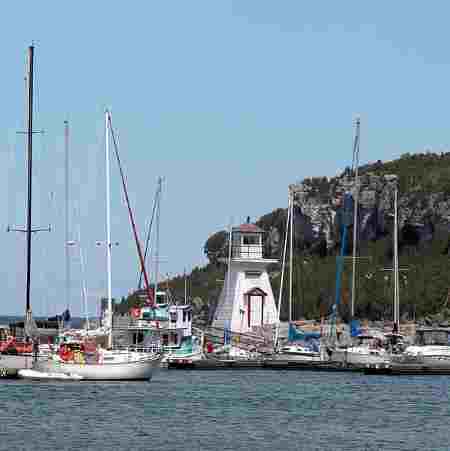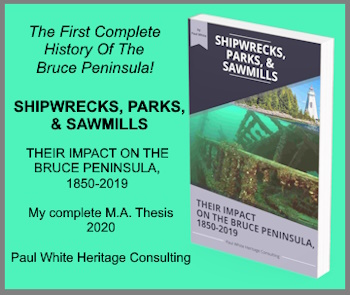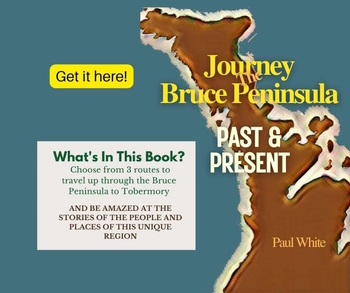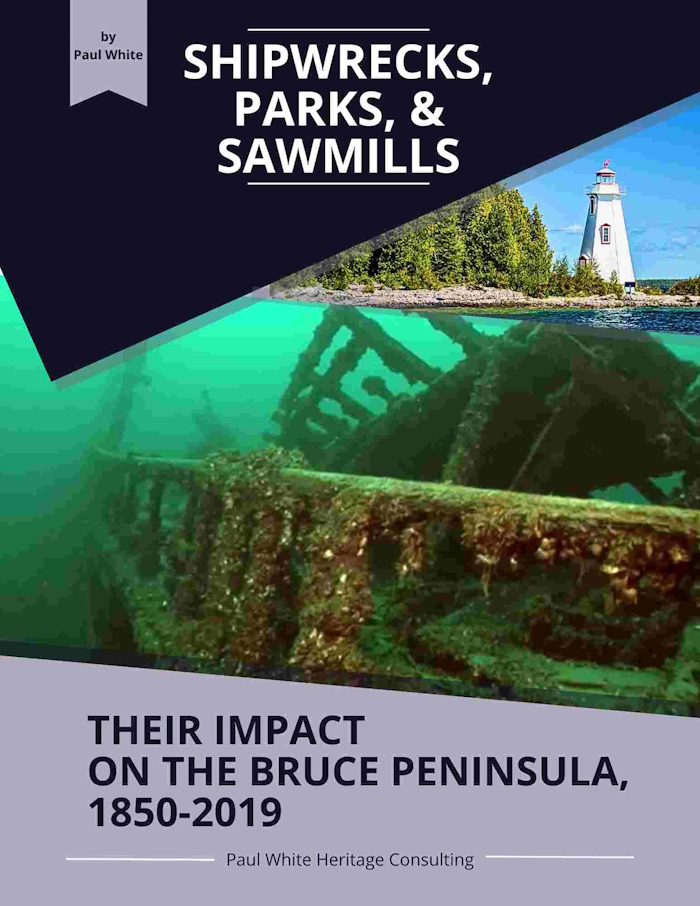Lion's Head
A Sailors Refuge
Lion's Head Lighthouse With The Lion's Head Directly Behind It
 Lion's Head Lighthouse Today Is a Replica Built By Local High School Students
Lion's Head Lighthouse Today Is a Replica Built By Local High School StudentsBehind Is The The "Lion's Head" Profile
Lion’s Head probably welcomed its first visitors/settlers in the 1860s. But, prior to that, sailors had often sought refuge from the stormy Georgian Bay waters in its well-protected harbour.
Travel was not always so easy, or pleasant, on the Bruce Peninsula in the early days! Most land traffic had to follow the rough-hewn paths used by Indigenous hunters. Therefore, many of the first settlements were more easily reached by water than by land.
Today there are many reasons why cottagers choose to build their holiday retreats on the peninsula.
However, the magnificent Georgian Bay sun rises, or the romantic Lake Huron sunsets were not the main reason why early settlers chose a life on the Bruce Peninsula.
From early newspaper reports we know that fishermen were visiting Tobermory by the early 1850s.
However, the rest of the Upper Peninsula did not welcome pioneers in any numbers until almost two decades later.
The first settlers usually arrived by boat and took up land close to the shoreline. Consequently, the first areas settled were in bays and inlets along the peninsula's coastline.
First Settlers Arrive at Lion's Head
In the1860s settlers arrived on the eastern shores of the Bruce Peninsula.
Isthmus Bay was well known to the early sailors on Georgian Bay.
Not only did it afford a safe haven from rough stormy waters, but it was also recognizable for an image that jutted out of the rocky outcropping which marked Point Hangcliff where it protruded into Georgian Bay on the southern limit of Isthmus Bay.
Centuries of wind, snow and rain carved what many considered to be the image of the head of a lion on the rocky outcropping.
Many sailors, and later the settlers of the area, came to think of the lion as the protector of the waters of Isthmus Bay. Consequently, it was not long after the settlers arrived that the small settlement was re-named Lion’s Head.
In 1875 Lion’s Head boasted the only store in Eastnor Township. In the same year a post office was opened in the community.
In 1879 Robert Watt built a saw and gristmill in the community. At that time the community had about one hundred citizens, two stores, a black smith shop and a pump factory.
This was a boom time in the community. By 1883, the population had doubled, and the commercial sector boasted five stores and two hotels.
Lion’s Head was a regular port of call for the vessels that supplied the coastal trade on the peninsula.
As well, increased lumbering activity in the area meant that area logs and other wood products were being shipped out of the region to distinations as far as the American mid-west.
In order to facilitate the increased port activity a new wharf was built. In 1883, amid expectation of increased shipping traffic the community petitioned the government to dredge the harbour to enable larger vessels to call at Lion’s Head.
The government responded to this request and equipment to dredge the harbour arrived the same year.
Lion’s Head remained an important lumbering centre into the twentieth century.
Today Lion’s Head is a centre of tourism, and the lion’s head still guards the southern entrance to the bay.
However, the same elements that created the image have continued to erode the rocky outcropping. Some claim that the lion has disappeared, but if you look closely, you can still see it watching over mariners seeking refuge in the beautiful Isthmus Bay.
The information used in this story came from many sources. However, the most important was Norman Robertson’s History of the County of Bruce.
This Article originally appeared in my weekly Local History column in the Owen Sound Sun Times.
For more interesting stories about the history of the Bruce Peninsula check out my book Journey the Bruce Peninsula Past & Present it makes a great travel companion as you travel this unique part of Canada's Great Lakes region.
Discover More About the Bruce Peninsula
Getting to the Bruce Peninsula is a relatively easy driving trip. Here are driving directions from three regions to the peninsula.
Bruce Peninsula Lumber History details the impact of the forest products industry on the development of the region.
Bruce Peninsula Lumbering provided the stimulus to develop and grow the pioneer economy on the newly settled Bruce Peninsula.
Bruce Peninsula Municipal Politics: No matter what the venue, or the issue, seldom is a popular decision made that suits everyone.
Bruce Peninsula Travel Routes were often a matter of debate because in the early years, land travel was virtually unattainable for settlers and lumbermen alike.
Bruce Peninsula winters could be difficult, especially in pioneer times when transportation connections were limited to only a few months each year.
Colpoys Bay Vista - Awesome! A short drive from either Wiarton or Owen Sound is one of the most magnificent views to be found in the province of Ontario!
Forest Products on the Bruce Peninsula contributed greatly to the growth and development of that region of the province of Ontario.
Gillies Lake: aka Ghost Lake has a mysterious past as its original name, Ghost Lake, implies.
Great Grey Owls on the Bruce Peninsula was a surprise discovery for ornithologists and others. Sadly, the story of their visit had an unfortunate conclusion.
Pioneer Campers: Hope Bay mostly considered the peninsula untamed wilderness and some of the locals were not about to disappoint them!
Pioneer Missionary James Atkey arrived on Colpoys Bay to minister to the native community near Oxenden until a treaty uprooted his parishioners.
Pioneer tourists first visited the Bruce Peninsula in the 1800s and the region continues as a great recreational and tourism destination today!
Pioneer Vacations on the Bruce Peninsula got an eerie start in the Hope Bay region of the peninsula.
Lighthouses Lighthouses were vital to Georgian Bay Sailing.
A Flowerpot Island cruise is not only entertaining, but it is also very educational as you will see things that you have never viewed before!
Travel the Bruce: Owen Sound to Wiarton A wonderful journey from Owen Sound to Wiarton.
Travel the Bruce: Wiarton to Tobermory Relaxing and historic journey.
Bruce Peninsula The Bruce Peninsula is a compelling place, with a rich history, to visit. Once you have traveled there, we guarantee that you will return, again and again!





